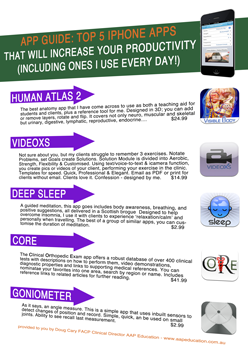|
Hi
Another Possible Mechanism of Action for Dry Needling

Dr. Ben Wand blogged on the Body in Mind site recently about a research project, that his team has just published in British Journal Sports Medicine.
Method
They looked at 25 people with chronic low back pain who were enroled in a randomised cross-over experiment. They compared the effect of acupuncture (using 14 needles in commonly agreed TCM points for back pain) delivered when sensory discrimination was optimised (by asking participant to locate on a picture where their needles were placed) to acupuncture delivered when it is not optimised (asked participant to relax and ignore the needling), on movement-related back pain immediately after each intervention.
Outcome
They reported that the average pain intensity after participants had received acupuncture with sensory discrimination training (2.8 ± 2.5) was less than when they received acupuncture without sensory discrimination training (3.6 ± 2.0). This difference was statistically significant (after adjustment; mean difference = -0.8, 95% CI -1.4 to -0.3; p = 0.011).
You can view Ben’s full blog post here.
As Ben notes this is hardly a clinical game changer, but it does raise interesting questions about self-perception/bodily awareness, pain and effects beyond just the placebo. From a lot of other high quality chronic low back pain research we know that neither sham or verum acupuncture is significantly better (hence attributing both to a placebo effect), but that they are both better than usual care. We also know people with chronic low back pain have altered brain structures as viewed on neuroimaging studies and local factors like tactile acuity, proprioception and neglect exist in this same population.
If you scroll to the bottom of Ben's blog in the Comments section, the second comment is a great example of a complex clinical situation in medical terms, that had an absolutely amazing outcome on any measuring stick, especially personally for Jeisea’s. If this method of treatment sparks a level of interest, you can read more about Yamamota’s New Scalp Acupuncture: principals and techniques. This is a pretty comprehensive and free download, for those without access to journals. I am not trained in this area, but it is very interesting.
The article also has a great section detailing the importance of safety when needling in the thoracic spine zone, including some color pictures of ‘fresh’ cadavers and the relative needle penetration through the intercostals. This is exactly the reason why we teach the technique of locating and using a rib as backstop, when treating thoracic trigger point techniques in our Advanced Upper Quadrant Dry Needling Course. Also why we make available our Wet Anatomy Lab Workshops on a regular basis so clinicians can refresh their visual 'under-the-skin' picture of clients.
Going back to Ben’s research, my own take is that DN/Acupuncture would already tend to be done in the dermatone of an irritated segment - like Ben is suggesting - when the situation is for increased stimulation. The concept being to increase the sensory input feeding back into the spinal cord lamina from which the chronic pain is being perceived, thinking to increase endogenous opioid release locally and from descending pathways.
On reflection, another possibility from this research is that in getting clients to locate their pain visually, they are actively thinking/associating/experiencing acute pain (that is true pain & activating an appropriate protective response) in an area that has predominately/totally been perceiving chronic pain. So perhaps it helps the brain recognise/recalibrate/localise what is a normal pain sensation cf. the abnormal/altered pain sensations they had previously been experiencing.
Master Needling Course Goes Country

Master Needling Aspirant Alert - following strong hints from recent Advanced Course participants the ultimate course in our dry needling program for 2015 will be held in Esperance. Seems a lot of people want to visit the best place on Earth.... So while this may seem a long way off, it is during a popular time for visitors, so we would suggest you consider making accommodation inquiries and arrangements soon. Would be a shame if you had to sleep with the kangaroos on the beach at Lucky Bay!!
All the best,
Doug Cary FACP
Specialist Musculoskeletal Physiotherapist (awarded by Australian College of Physiotherapy, 2009)
PhD Candidate Curtin University
Clinical Director AAP Education
email: doug@aapeducation.com.au
ph/fx: 08 90715055
Receive a FREE Information Report

Choose The Top 5 Manual Therapy Apps or Infection Control & Needling (V2)
Along with the report you'll also get a complimentary subscription to "Clinical Kit" our regular eZine (email newsletter) and Free Bronze Membership. You'll get ideas, information, insight and inspiration on a regular basis, plus access to our Resource Library, helping you unravel those clinical conundrums appearing every day.
You are free to use material from the Blog in whole or in part, as long as you include complete attribution, including live website link. Please also notify me where the material will appear. The attribution should read: "By Doug Cary FACP of AAP Education. Please visit our website at www.aapeducation.com.au for additional clinical articles and resources on post graduate education for health professionals" (Please make sure the link is live if placed in an eZine or in a web site.)
Dry Needling Program | Outcome Measures and Screening Tools | Integrated Neck Solutions | MSK & RT Ultrasound | Accredited Courses | Wet Lab Anatomy Workshop | The Shoulder | Mulligan Courses | 100% GUARANTEE | BLOG
   
|

